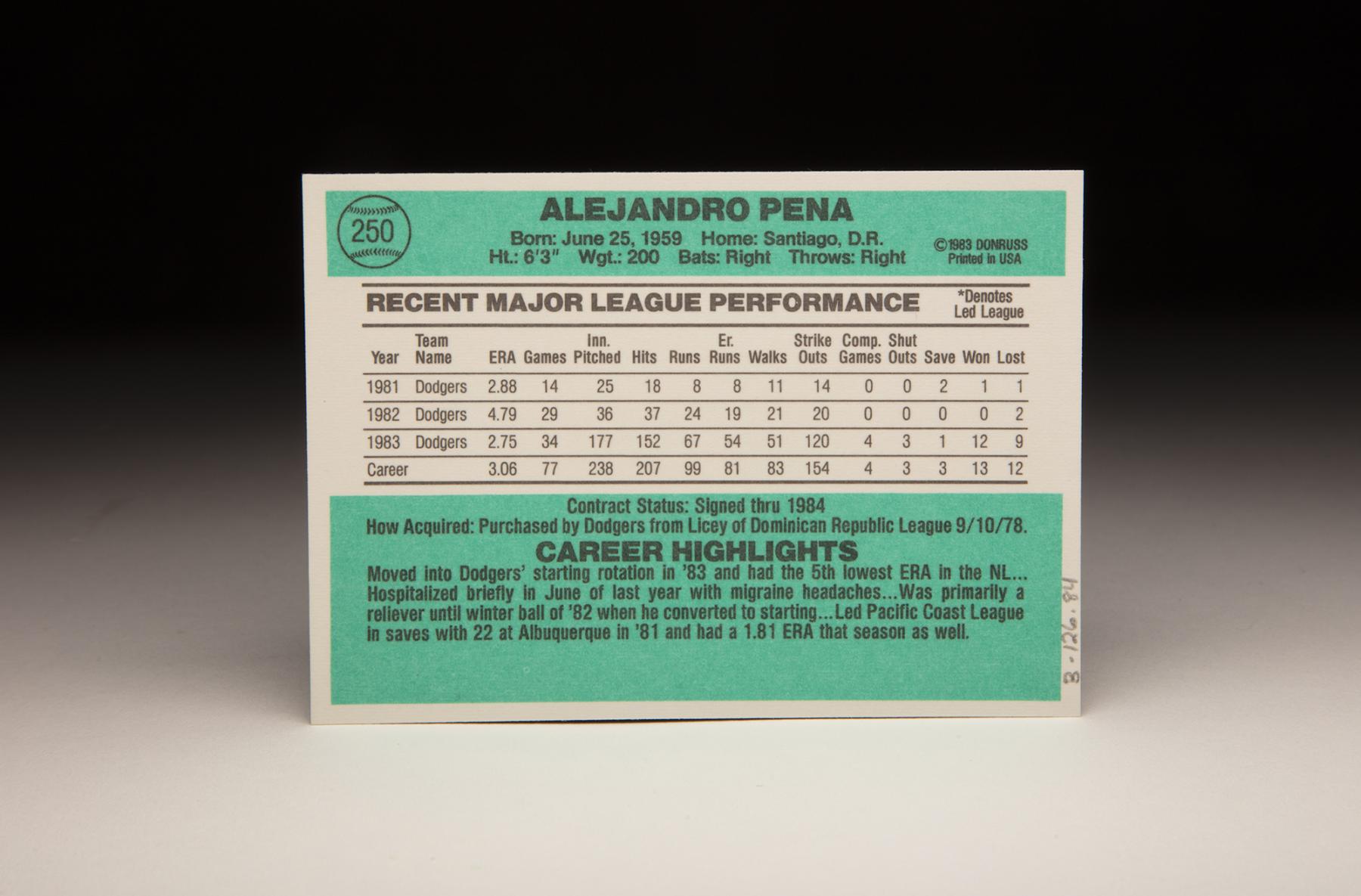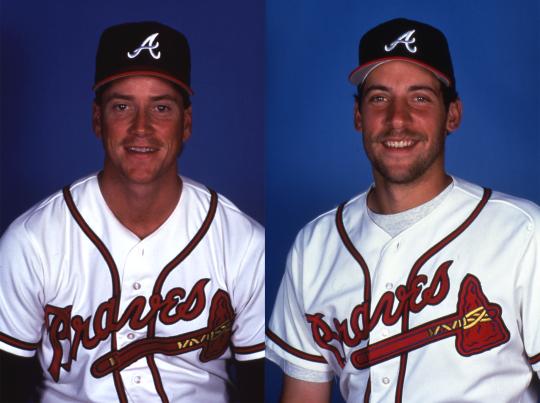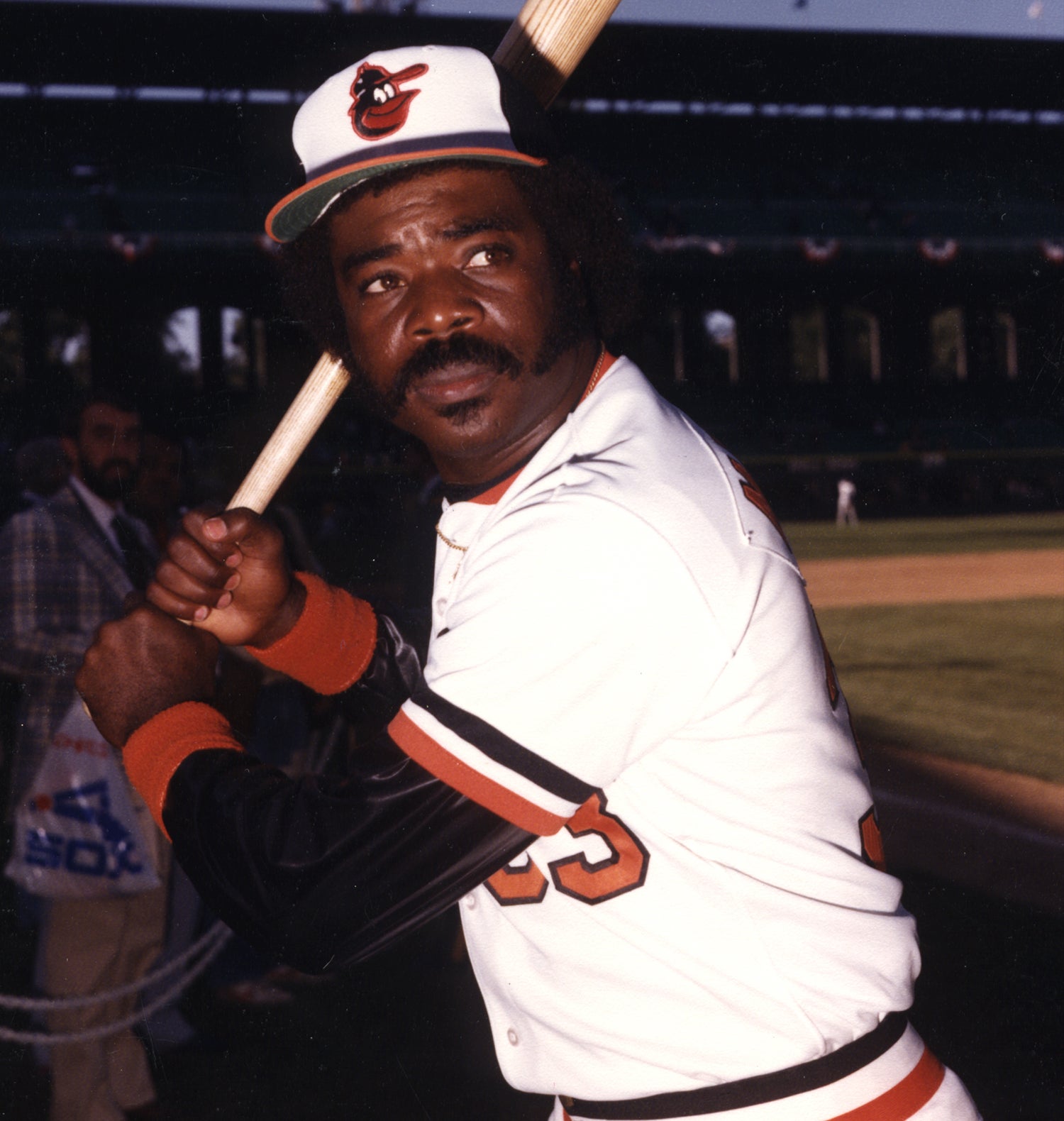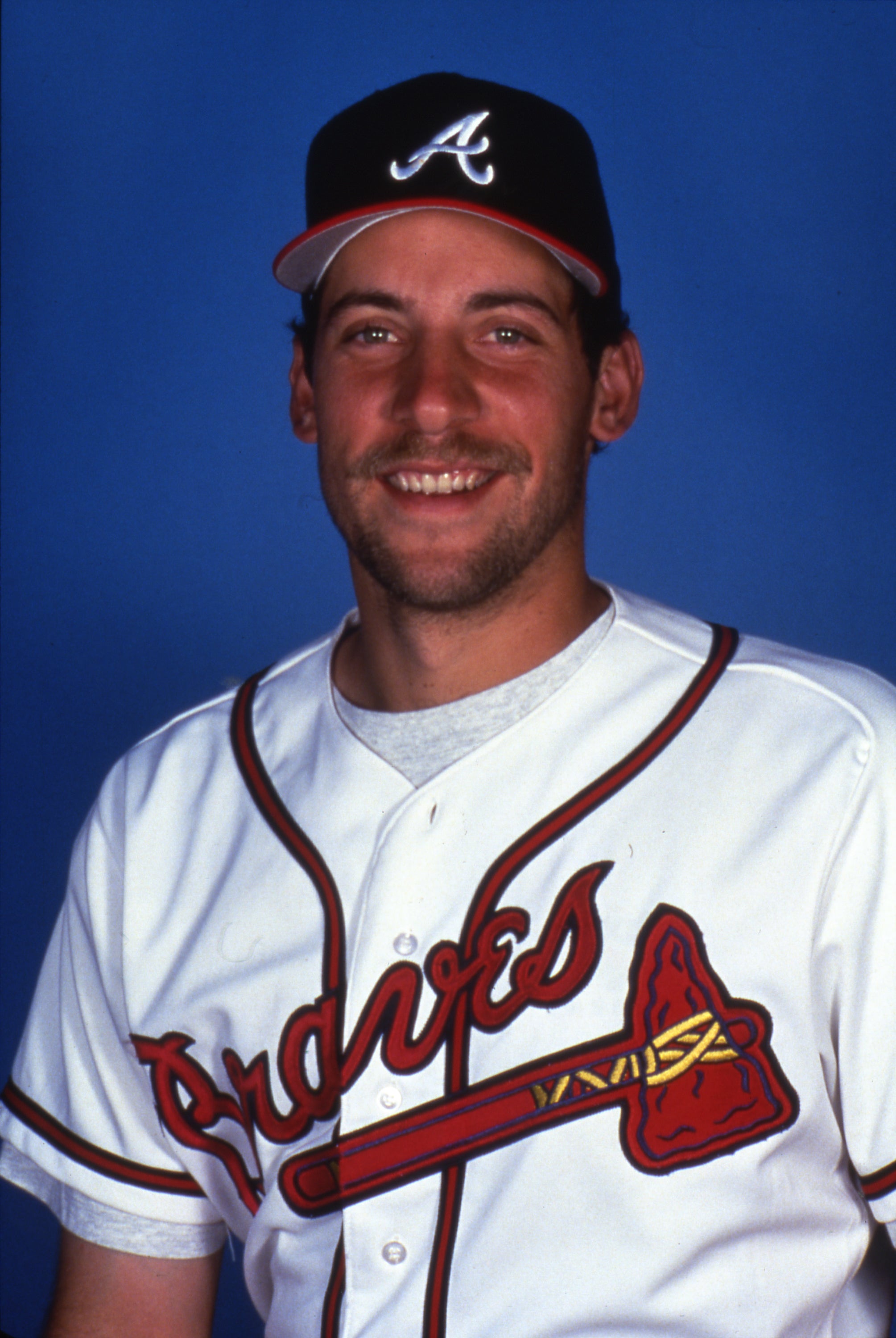- Home
- Our Stories
- #CardCorner: 1984 Donruss Alejandro Peña
#CardCorner: 1984 Donruss Alejandro Peña
When the Atlanta Braves began their record-setting string of 14 straight postseason appearances in 1991, the future Hall of Fame starting pitching duo of Tom Glavine and John Smoltz led the way.
But without reliever Alejandro Peña, that streak might have been put off by at least one year. Because for September and October of that season, Peña was virtually perfect.
Born June 25, 1959, in Cambiaso, Dominican Republic, Peña grew up in a working class family and did not begin playing organized baseball until his teens – spending much of his youth with his father building charcoal-burning dirt ovens. But with scouts combing the island for talent in the 1970s, Peña began attending tryout camps – and eventually his strong right arm caught the eye of the Dodgers.
“I told him that his only chance, in my opinion, to sign a contract was to become a pitcher,” Dodgers scout Ralph Avila, who first saw Peña when he was a third baseman, told the Los Angeles Times.
Peña signed with Los Angeles on Sept 10, 1978, for a $4,000 bonus and was sent to Class A Clinton of the Midwest League the following year, where he was 3-3 with a 4.18 ERA in 21 games.
Hall of Fame Membership
There is no simpler, and more essential, way to demonstrate your support than to sign on as a Museum Member.
Official Hall of Fame Merchandise
Hall of Fame Members receive 10% off and FREE standard shipping on all Hall of Fame online store purchases.
Then in 1980, Peña burst onto the Dodgers’ prospect radar by going 10-3 with eight saves and a 3.21 ERA for Class A Vero Beach. Promoted to Triple-A Albuquerque in 1981, Peña was fast-tracked as a reliever, going 2-5 with a 1.61 ERA and 22 saves in 38 appearances.
“He’s just a young man with a great future,” Sandy Koufax, the Dodgers’ roving pitching instructor, told the News Tribune in Tacoma, Wash., that June. “I saw him in Spring Training, so I know he can throw.”
The Pacific Coast League record of 25 saves was well within Peña’s reach, but when the MLB season resumed in August after the strike the Dodgers immediately brought Peña to the big leagues. He did not allow a run over his first 7.1 innings and finished the year with a 1-1 record, two saves and a 2.84 ERA in 14 games as the Dodgers advanced to the postseason after winning the first half title in the NL West.
Peña did not appear in the NLDS vs. the Astros, but worked two scoreless outings against the Expos as the Dodgers won the NLCS and advanced to the World Series. But Peña was the only player on the Dodgers Fall Classic roster not to appear against the Yankees in Los Angeles’ six-game victory; he was hospitalized after Game 2 due to a bleeding ulcer.
Peña began the 1982 season as one of the key members of the Dodgers’ bullpen, necessitating the demotion of Tom Niedenfuer – another hard-throwing reliever who debuted in 1981 – to Triple-A. But after pitching to a 1.29 ERA in his first 13 games, Peña began to struggle and was sent back to Albuquerque on June 8 with an 0-1 record and 4.28 ERA. Peña was recalled briefly in June when Burt Hooton went on the disabled list but soon returned to Triple-A for the rest of the season.
He finished 1982 0-2 with a 4.54 ERA with the Dodgers and 1-1 with a 5.34 ERA and five saves with Albuquerque, prompting offseason trade rumors to swirl.
“We’d have to consider that one,” Rangers general manager Joe Klein told the Fort Worth Star-Telegram of a proposed trade that would have sent catcher Jim Sundberg to the Dodgers in exchange for Peña, Mike Marshall and Dave Stewart.
But the Dodgers held onto Peña and he secured a spot on the team’s Opening Day roster in 1983. After pitching effectively out of the bullpen in April, Peña moved into the starting rotation in May and began consistently delivering quality starts. But in a June 16 game against the Braves, Peña felt something pop in his shoulder on a pitch to Dale Murphy. He hid the injury from trainers – a decision that would eventually haunt him.
“He’s a tough guy and he doesn’t say much,” Dodgers team doctor Frank Jobe told the Los Angeles Times. “(But) you can’t operate on everybody that has a sore arm.”
Peña completed the 1983 season – despite migraine headaches that hospitalized him at one point – with a 12-9 record and a 2.75 ERA over 177.0 innings. The Dodgers won the NL West but lost in the NLCS to the Phillies, where Peña was limited to just one appearance and 2.2 innings.
“When I pitch, I don’t feel pressure at all,” Peña told the Los Angeles Times. “But I think I worry too much. I keep everything inside of me.”
In 1984, Peña was even better than the year before – going 12-6 with a big league-leading 2.48 ERA over 28 starts, pacing the NL with four shutouts. But Peña continued to experience pain and reported that a winter’s rest did nothing to ease it. On the eve of Spring Training of 1985, Jobe operated on Peña’s right shoulder.
He told Peña after the procedure that he might never pitch again. He appeared in just two games in 1985 – his first coming on Sept. 13 – and allowed four earned runs over 4.1 innings.
“It was a hard year, yeah,” Peña told the Los Angeles Times. “I think it happened because I threw too many fastballs. I threw only fastballs, 90 miles per hour every time.”
But Peña diligently worked at rehabilitating his arm and returned to the Dodgers’ bullpen in late May of 1986. By July, he was back in the starting rotation – but he finished the year with a 1-2 record and a 4.89 ERA in 24 appearances.
He told Peña after the procedure that he might never pitch again. He appeared in just two games in 1985 – his first coming on Sept. 13 – and allowed four earned runs over 4.1 innings.
“It was a hard year, yeah,” Peña told the Los Angeles Times. “I think it happened because I threw too many fastballs. I threw only fastballs, 90 miles per hour every time.”
But Peña diligently worked at rehabilitating his arm and returned to the Dodgers’ bullpen in late May of 1986. By July, he was back in the starting rotation – but he finished the year with a 1-2 record and a 4.89 ERA in 24 appearances.
Los Angeles would go on to win the series in seven games.
“He has that heavy, moving, sinking fastball that makes him tough,” Dodgers pitching coach Ron Perranoski said. “He comes in and throws strikes.”
In the World Series against Oakland, Peña entered Game 1 in the eighth inning and kept the Dodgers within one run with two scoreless frames. Then in the bottom of the ninth with two outs and no one on against A’s closer Dennis Eckersley, Mike Davis – pinch hitting for Alfredo Griffin – drew a walk. Peña was the next scheduled batter but was replaced by Kirk Gibson, who was battling leg injuries and did not start the game.
Gibson’s legendary homer followed, giving the Dodgers a 5-4 victory and making Peña the winner.
Peña was icing his arm in the trainer’s room when Gibson hit it out. He would pitch three shutout innings in relief in Game 3 – the only game of the series Oakland would win. Two days later, Hershiser would toss his second complete game of the Fall Classic, leading the Dodgers to a 5-2 win and the championship.
Peña worked as a set-up man in 1989, appearing in 53 games with a 4-3 record, five saves and a 2.13 ERA. But the Dodgers failed to repeat as NL West champions. And on Dec. 20, Los Angeles traded Peña and Mike Marshall to the Mets in exchange for Juan Samuel.
As the main caddy for closer John Franco, Peña was 3-3 with five saves and a 3.20 ERA in 52 games in 1990 as the Mets finished in second place behind Pittsburgh in the NL East. But in 1991, the Mets struggled – though Peña was a notable bright spot, going 6-1 with a 2.71 ERA in 44 games.
On Aug. 28, the Braves – making a push for their first postseason appearance since 1982 and having lost closer Juan Berenguer to injury – traded prospects Tony Castillo and Joe Roa to the Mets for Peña.
“Peña is one of those pitchers you can trust,” Braves manager Bobby Cox told El Nuevo Herald. “We needed a good reliever in a hurry and we were lucky to get Peña.”
Cox proved correct. After allowing two runs in 1.2 innings in his Braves debut on Aug. 31, Peña worked in 14 games through the end of the regular season – allowing a run in just one of them. Peña went 2-0 with 11 saves and a 0.51 ERA as the Braves won the NL West and advanced to the NLCS vs. Pittsburgh.
On Sept. 11, Kent Mercker, Mark Wohlers and Peña combined to no-hit the Padres – the first combined no-hitter in NL history.
Then in four outings against the Pirates in the NLCS, Peña allowed just two baserunners (one coming on an error) over 4.1 innings pitched, permitting just one hit and no runs while striking out four and earning three saves.
Peña saved three of the Braves’ four wins – with John Smoltz collecting the final victory in Game 7 with a complete game shutout.
In the World Series against the Twins, Peña worked three games – working two innings apiece in both Game 3 and Game 6. Then in Game 7, Peña entered the contest with two on and no outs in the bottom of the ninth of a scoreless game. He immediately got Shane Mack to ground into a double play, then ended the threat by striking out Paul Sorrento after intentionally walking Mike Pagliarulo.
But Minnesota starter Jack Morris kept the Braves off the scoreboard in the 10th, and in the bottom of the frame Dan Gladden led off with a double vs. Peña and advanced to third on a sacrifice by Chuck Knoblauch. Peña intentionally walked Kirby Puckett and Kent Hrbek to load the bases before Gene Larkin’s fly ball single to left field scored Gladden with the World Series-winning run.
“Nobody lost this game,” said Smoltz, who started the game and did not allow a run through 7.1 innings. “They flat-out won it.”
The Braves brought Peña back in 1992 with a one-year, $2.65 million deal. And though the Braves again won the NL West crown, this time Peña was the reliever who was injured in September as he dealt with shoulder tendinitis. He appeared in only three games in September and none in the postseason, finishing the year with a 1-6 record, 15 saves and a 4.07 ERA.
Now a free agent, Peña signed a one-year, $1.35 million deal with the Pirates. But before the season began, Peña underwent elbow surgery that would cause him to miss the entire 1993 season. He restructured his contract into a two-year deal and returned to Pittsburgh in 1994, where he was 3-2 with seven saves and a 5.02 ERA in 22 games despite missing time with bleeding ulcers. The Pirates released him on June 30, a few weeks before the strike ended the season.
When the strike ended, the Red Sox signed Peña for the 1995 season. But with a 1-1 record and 7.40 ERA in 17 games on June 13, Peña was released by Boston. He hooked on with the Marlins’ Triple-A team in Charlotte two weeks later and made his debut with Florida on Aug. 2, allowing runs in only one of his 13 appearances in August.
Then on Aug. 31, the Braves sent a player to be named later – who became Chris Seelbach – to the Marlins for Peña.
His late-season outings were not quite as successful as 1991, but Peña still appeared in 14 games in September, seven of which Atlanta won on the way to another division title. Cox then leaned on Peña heavily in the postseason, pitching him in three games in the NLDS vs. Colorado and three more in the NLCS vs. Cincinnati. Peña did not allow a run in any of them.
In the World Series against Cleveland, Peña recorded a scoreless inning of work in Game 2 as the Braves won 4-3 to take a 2-games-to-0 lead. Two days later in Game 3, Peña entered the contest in the bottom of the 11th with the score tied at six. Carlos Baerga led off with a double, and after walking Albert Belle intentionally, Peña allowed a single to Eddie Murray to give the Indians a 7-6 win.
Peña did not pitch again in the series, but the Braves hardly needed him as Atlanta won two of the next three games, including a 1-0 victory in the series-clinching Game 6 as Tom Glavine threw eight shutout innings and Wohlers collected the save.
“Let me tell you about Alejandro Peña,” Braves pitching coach Leo Mazzone told the Palm Beach Post in 1995. “I’ll never forget that day they asked him, ‘Alejandro, why are you saving so many games for Atlanta?’ He said the smartest thing I’ve ever heard a reliever say. He said: ‘I’ve only got to get three outs. I can do that with just my fastball.’
“His approach is the best I’ve been around, as far as the ninth inning.”
A free agent once again following the Braves’ World Series championship, Peña returned to the Marlins. But after four appearances in April, he developed shoulder issues and eventually underwent surgery. He would not pitch in the big leagues again.
He finished his career with a 56-52 record, 74 saves and a 3.11 ERA over 503 games. In 23 postseason appearances over nine series, Peña was 4-3 with four saves and a 2.03 ERA, earning two World Series rings with the Dodgers and another with the Braves.
“I just (give) it my best shot,” Peña said of his pitching style. “Strength against strength.”
Craig Muder is the director of communications for the National Baseball Hall of Fame and Museum
Related Stories

#CardCorner: 1984 Topps Rusty Staub
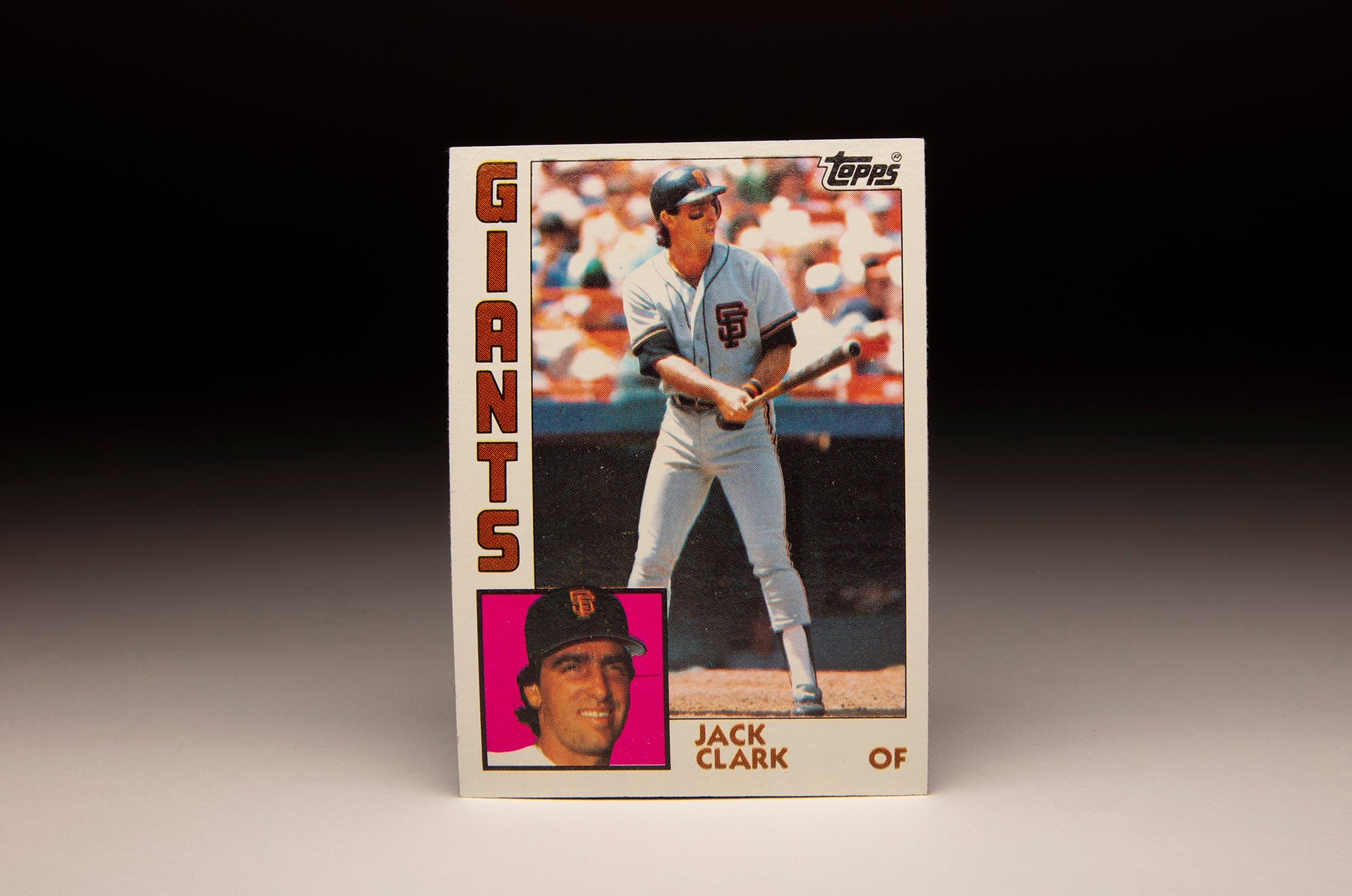
#CardCorner: 1984 Topps Jack Clark
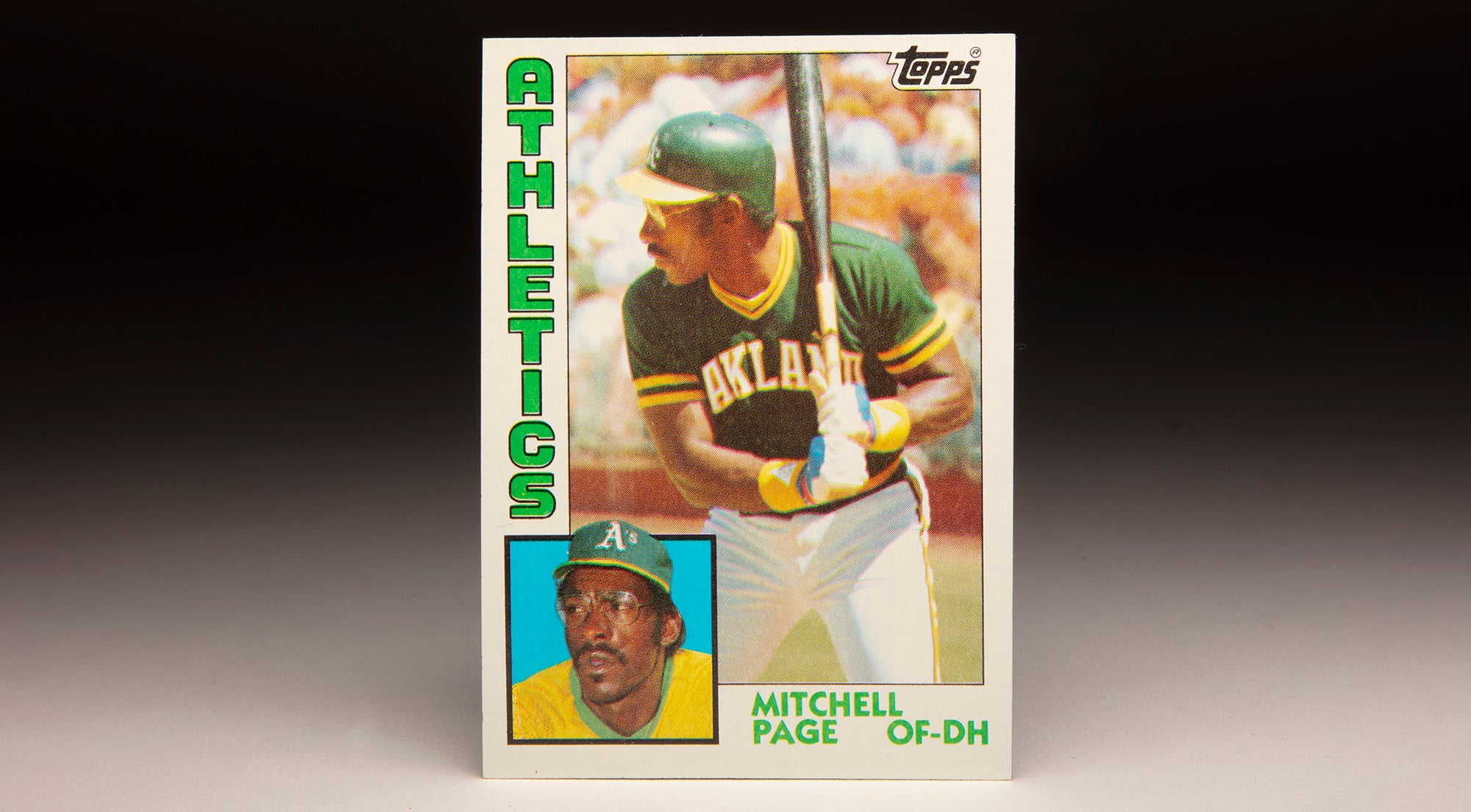
#CardCorner: 1984 Topps Mitchell Page
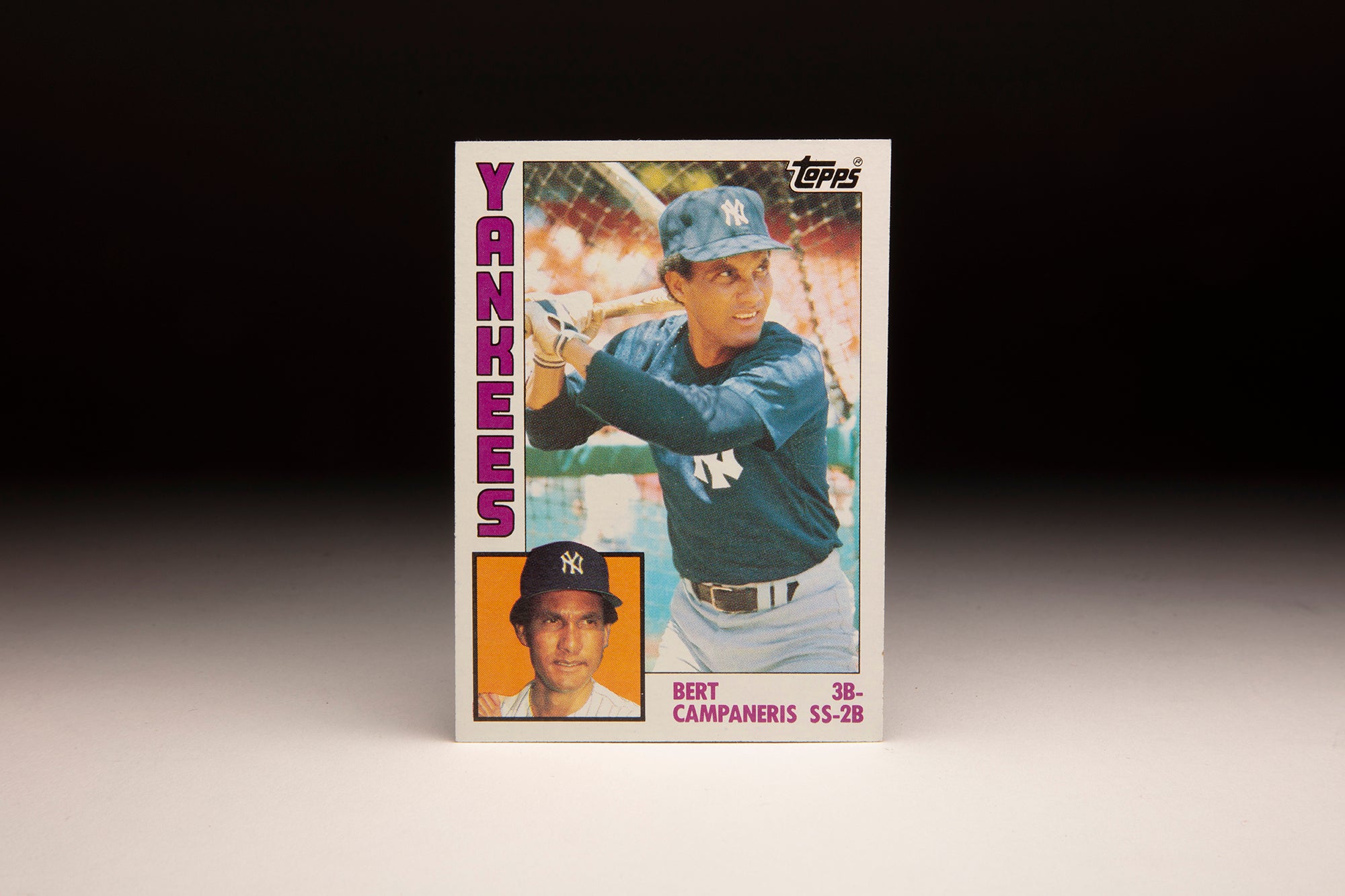
#CardCorner: 1984 Topps Bert Campaneris

#CardCorner: 1984 Topps Rusty Staub

#CardCorner: 1984 Topps Jack Clark

#CardCorner: 1984 Topps Mitchell Page



